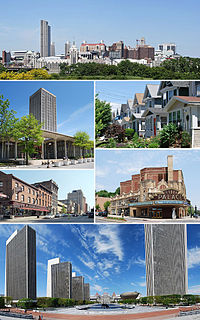Background
John Armstrong had been elected for this seat (term 1803–1809) in February 1804, after the resignation of Theodorus Bailey. Armstrong took his seat on February 25, but resigned on June 30, 1804, after his appointment as U.S. Minister to France.
At the State election in April 1804, the Democratic-Republican Party won a large majority in the Assembly, and all 8 State Senate seats up for election. The 28th New York State Legislature met from November 6 to 12, 1804; and from January 23 to April 10, 1805, at Albany, New York.

The 28th New York State Legislature, consisting of the New York State Senate and the New York State Assembly, met from November 6, 1804, to April 10, 1805, during the first year of Morgan Lewis's governorship, in Albany.

Albany is the capital of the U.S. state of New York and the seat of Albany County. Albany is located on the west bank of the Hudson River approximately 10 miles (16 km) south of its confluence with the Mohawk River and approximately 135 miles (220 km) north of New York City.
The 1797 United States Senate election in New York was held on January 24, 1797, by the New York State Legislature to elect a U.S. Senator to represent the State of New York in the United States Senate.
The first 1798 United States Senate special election in New York was held on January 11, 1798, by the New York State Legislature to elect a U.S. Senator to represent the State of New York in the United States Senate.
The second 1800 United States Senate special election in New York was held on November 6, 1800, by the New York State Legislature to elect a U.S. Senator to represent the State of New York in the United States Senate.
The 1801 United States Senate election in New York was held on January 27, 1801, by the New York State Legislature to elect a U.S. Senator to represent the State of New York in the United States Senate.
The 1802 United States Senate special election in New York was held on February 9, 1802, by the New York State Legislature to elect a U.S. Senator to represent the State of New York in the United States Senate.
The 1803 United States Senate election in New York was held on February 1, 1803, by the New York State Legislature to elect a U.S. Senator to represent the State of New York in the United States Senate.
The first 1804 United States Senate special election in New York was held on February 3, 1804, by the New York State Legislature to elect two U.S. Senators to represent the State of New York in the United States Senate.
The 1807 United States Senate election in New York was held on February 3, 1807, by the New York State Legislature to elect a U.S. Senator to represent the State of New York in the United States Senate.
The 1809 United States Senate election in New York was held on February 7, 1809, by the New York State Legislature to elect a U.S. Senator to represent the State of New York in the United States Senate.
The 1813 United States Senate election in New York was held on February 2, 1813, by the New York State Legislature to elect a U.S. Senator to represent the State of New York in the United States Senate.
The 1815 United States Senate election in New York was held on February 7, 1815, by the New York State Legislature to elect a U.S. Senator to represent the State of New York in the United States Senate.
The 1833 United States Senate election in New York was held on February 5, 1833, by the New York State Legislature to elect a U.S. Senator to represent the State of New York in the United States Senate.
The 1857 United States Senate election in New York was held on February 3, 1857, by the New York State Legislature to elect a U.S. Senator to represent the State of New York in the United States Senate.
The 1861 United States Senate election in New York was held on February 5, 1861, by the New York State Legislature to elect a U.S. Senator to represent the State of New York in the United States Senate.
The United States Senate elections of 1856 and 1857 were elections which had the young Republican Party assume its position as one of the United States's two main political parties. The Whigs and Free Soilers were gone by the time the next Congress began.

The 1808 United States House of Representatives elections in New York were held from April 26 to 28, 1808, to elect 17 U.S. Representatives to represent the State of New York in the United States House of Representatives of the 11th United States Congress. At the same time, a vacancy was filled in the 10th United States Congress.
The United States Senate elections of 1860 and 1861 were elections corresponding with Abraham Lincoln's election to the presidency. The nascent Republican Party increased their Senate seats in the general elections, and after southern Democrats withdrew to join the Confederacy, Republicans gained control of the United States Senate. To establish a quorum with fewer members, a lower total seat number was taken into account.
The United States Senate elections of 1862 and 1863 were elections during the American Civil War in which Republicans increased their control of the U.S. Senate. The Republican Party gained three seats, bringing their majority to 66% of the body. Also caucusing with them were Unionists and Unconditional Unionists. As many Southern states seceded in 1860 and 1861, and members left the Senate to join the Confederacy, or were expelled for supporting the rebellion, seats were declared vacant. To establish a quorum with fewer members, a lower total seat number was taken into account.

The 27th New York State Legislature, consisting of the New York State Senate and the New York State Assembly, met from January 31 to April 11, 1804, during the third year of George Clinton's second tenure as Governor of New York, in Albany.








